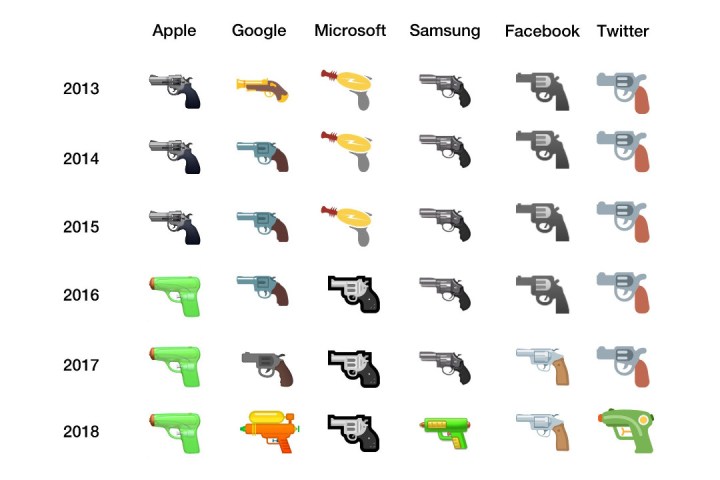
An update to Android’s inbuilt emoji database will change the pistol emoji into a Super Soaker-style water pistol, bringing Google’s operating system in line with a growing trend over the last couple of years.
The change was first reported by Emojipedia, which noticed the changing of Google’s emoji repository on GitHub. The change sees the emoji morph from a realistic gunmetal grey and brown revolver into an orange Super Soaker-style water gun, complete with a large water reservoir on top. This change comes contrary to previous statements by Google employees that the company was not looking to change the gun emoji design, despite other emoji databases changing to a water gun design.
This change in Google’s decision is most likely to promote “emoji-parity” across all different platforms, but it’s also likely that the change has come as a result of an increasingly controversial topic of gun control and violence in the United States, and changing to a less controversial image is favorable for the company. It’s expected that this change will go live in the next major Android update — expected to be Android P.
Apple was one of the forerunners of the water gun design, changing its gun emoji into a simple green water pistol in August 2016. Other companies were slow to pick up on the trend, but we’ve recently seen Samsung and Twitter follow suite with similar-looking green designs. Google’s design is the most dissimilar to Apple’s original design, but it’s clear that the search engine giant is looking to emulate a similar aesthetic and feel.
Interestingly, Microsoft’s gun emojis have gone the opposite way to the norm, changing from an alien ray gun design to a more realistic revolver shortly after Apple’s redesign. This came despite Microsoft’s unity with Apple in opposing a rifle emoji.
Changes to emojis are nothing new, though they’re often much less notoriously controversial than the gun emoji. Google changed its cheeseburger emoji last year following a righteous outcry on Twitter over the placement of the cheese, while Apple’s newest set of emojis are helping to promote a larger sense of inclusion, with a new set of emojis for disabled people. Development of new types of emojis is also rampant, with Apple’s Animojis and Samsung’s AR Emojis using augmented reality to create more personalized emojis.
Editors' Recommendations
- A new Google Pixel Tablet is coming, but it’s not what you think
- Android 15 release date: When will my phone get the update?
- Google just released the first Android 15 beta. Here’s what’s new
- This Google Pixel 8a leak just spoiled everything about the phone
- These are the best Android 15 features you need to know about
